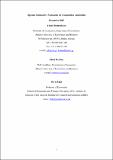Files in this item
Optimal substantive standards for competition authorities
Item metadata
| dc.contributor.author | Katsoulacos, Yannis | |
| dc.contributor.author | Metsiou, Eleni | |
| dc.contributor.author | Ulph, David Tregear | |
| dc.date.accessioned | 2016-02-03T00:12:02Z | |
| dc.date.available | 2016-02-03T00:12:02Z | |
| dc.date.issued | 2016-09 | |
| dc.identifier | 181750833 | |
| dc.identifier | 8746eed9-1dc4-480e-a8bb-525f91bdafa7 | |
| dc.identifier | 84981513390 | |
| dc.identifier | 000413903500001 | |
| dc.identifier.citation | Katsoulacos , Y , Metsiou , E & Ulph , D T 2016 , ' Optimal substantive standards for competition authorities ' , Journal of Industry, Competition and Trade , vol. 16 , no. 3 , pp. 273-295 . https://doi.org/10.1007/s10842-015-0214-8 | en |
| dc.identifier.issn | 1566-1679 | |
| dc.identifier.other | ORCID: /0000-0003-3171-1270/work/59464524 | |
| dc.identifier.uri | https://hdl.handle.net/10023/8121 | |
| dc.description | Initial research was funded by an ESRC grant RES-052-23-221I “Optimal Enforcement and Decision Structures for Competition Policy” and subsequently it has been co-financed by the European Union (European Social Fund – ESF) and Greek National funds through the Operational Program “Education and Lifelong Learning” of the National Strategic reference Framework (NSRF) – Research funding program: ARISTEIA – Competition, Law Enforcement and Growth. | en |
| dc.description.abstract | Recent years have witnessed a significant resurgence in the debate concerning the optimal substantive standard to be used in the enforcement of competition law. One of the arguments proposed for using a Consumer Surplus standard, is that, when firms can choose from a number of mutually exclusive actions, it may induce firms to adopt actions that lead to a higher level of total welfare than would a Total Welfare standard. This important basic insight, initially due to Lyons (2002), has been discussed and extended in the recent literature always in the context of mergers. In this paper we generalise and re-examine this argument for any potentially anti-competitive action – we have in particular in mind actions often challenged as attempted monopolisation (abuse of dominance) or vertical restraints, taken by firms in different environments. We show that in the absence of any efficiencies the two standards lead to exactly the same outcomes but a choice between them becomes important in the presence of efficiencies. With positive marginal-cost reducing efficiencies we confirm the presence of what we term a Lyons-effect in our more general setting. We then examine how the choice of standard depends on a number of relevant parameters. Most important in terms of their policy implications are the results that the Consumer Surplus standard will be the optimal choice, when the extant market power is significant, when the size of marginal cost-reducing efficiency effects is large and when the difference in the market power raising effects of mutually exclusive actions is large. These results are important since they suggest that in all cases where significant extant market power is a prerequisite for the enforcement of Competition Law it is best to use a Consumer Surplus standard. | |
| dc.format.extent | 23 | |
| dc.format.extent | 537757 | |
| dc.language.iso | eng | |
| dc.relation.ispartof | Journal of Industry, Competition and Trade | en |
| dc.subject | Antitrust enforcement | en |
| dc.subject | Antitrust law | en |
| dc.subject | Consumer Surplus Standard | en |
| dc.subject | Substantive Standards | en |
| dc.subject | Total Welfare Standard | en |
| dc.subject | HB Economic Theory | en |
| dc.subject.lcc | HB | en |
| dc.title | Optimal substantive standards for competition authorities | en |
| dc.type | Journal article | en |
| dc.contributor.sponsor | Economic & Social Research Council | en |
| dc.contributor.institution | University of St Andrews. School of Economics and Finance | en |
| dc.identifier.doi | 10.1007/s10842-015-0214-8 | |
| dc.description.status | Peer reviewed | en |
| dc.date.embargoedUntil | 2016-01-30 | |
| dc.identifier.grantnumber | RES-062-23-2211 | en |
This item appears in the following Collection(s)
Items in the St Andrews Research Repository are protected by copyright, with all rights reserved, unless otherwise indicated.

